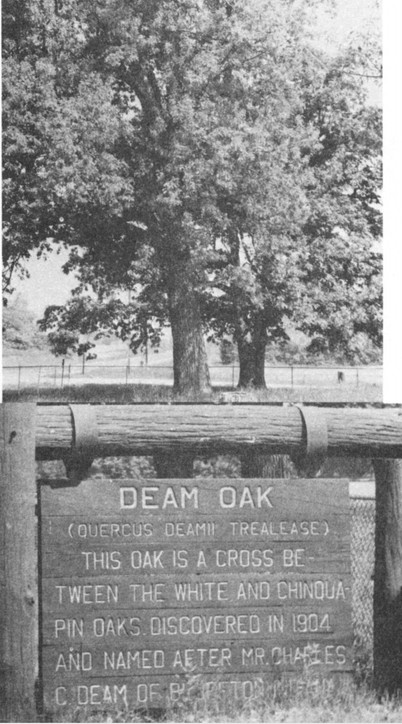Deam Oak Monument Forest
Introduction
Text-to-speech Audio
Images
Deam Oak Tree

Backstory and Context
Text-to-speech Audio
Charles C. Deam is significant in Indiana agricultural history as a famous botanist who traveled throughout nearly all of the state of Indiana surveying the land and collecting data on numerous different plant species. Originally a graduate of DePauw University and working for the Deam & Harris Drug Store in Bluffton, Indiana. At a doctor's request to spend more time outdoors, Charles C. Deam took up and interest in the local environment that soon grew to a full time endeavor.
Deam held positions such as Secretary of the State Board of Forestry (1909-1913), State Forester (1917-1940) and as president of the Indiana Academy of Science. Famous publications from Deam include "Trees of Indiana," "Grasses of Indiana," and "Shrubs of Indiana," among others.
According to an article within the Indiana Magazine of History by Paul Weatherwax, Deam's monumental work "Flora of Indiana" "included 1,838 species regarded as native to the state and 302 adventive species."
In close connection with farmers, Deam himself had great insight into invasive species and predictions for future issues. According to Paul Weatherwax, "Deam was a pioneer in sounding an alarm about the introduction of plants not native to our area. Sometimes this was only an
academic concern, an objection to the 'pollution' of the natural flora, but in other instances he was alarmed about the introduction of species which might become bad weeds." and "Especially in the southern half of the state farmers can testify to the accuracy of this unheeded prophecy." (Weatherwax, pg. 232)
Deam represents a piece of Hoosier agricultural history that lends itself to the knowledge revolution within the state, and how institutions and funded research changed the understanding of the surrounding area. This bleeds into other aspects beyond native species, such as more efficient ways to plant and care for crops.
Sources
Weatherwax, Paul. Charles Clemon Deam: Hoosier Botanist. Indiana Magazine of History. September 1st 1971. 197 - 262.
Barnes, William B. . The Journal of Wildlife Management, vol. 18, no. 3397 - 398. Published July 1st 1954.
Hibben, G. (2012). Charlie Deam and the Deam Oak . Arnoldia, 69(4), 15–21. Retrieved from https://www-jstor-org.proxyiub.uits.iu.edu/stable/pdf/42955529.pdf?ab_segments=0/basic_SYC-5152/control&refreqid=search:12182dd92afce56604178a71c4d9b1e4
https://www-jstor-org.proxyiub.uits.iu.edu/stable/pdf/27789749.pdf?ab_segments=0%2Fbasic_SYC-5152%2Fcontrol&refreqid=search%3A7395cb9c8806ca9e7e172e32c82edf69
